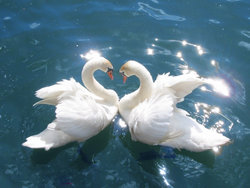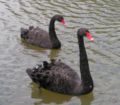| Swans | ||||||||||||
|---|---|---|---|---|---|---|---|---|---|---|---|---|

Mute Swan
|
||||||||||||
| Scientific classification | ||||||||||||
|
||||||||||||
Cygnus Bechstein 1803
Coscoroba Reichenbach 1853
Sarcidiornis
|
Swans are large water birds of the family Anatidae, which also includes geese and ducks. Swans are grouped with the closely related geese in the subfamily Anserinae.
Swans usually mate for life, though "divorce" does sometimes occur, particularly following nesting failure. The number of eggs in each clutch is between 3–8.
The word is derived from Old English swan, akin to German schwan, in turn derived from Indo-European root *swen (to sound, to sing), whence Latin derives sonus (sound). (Webster's New World Dictionary) Young swans are known as cygnets, from the Latin word for swan, cygnus. An adult male is a "cob", an adult female is a "pen".
Contents |
Coloration
The Northern Hemisphere species of swan have pure white plumage, but the Southern Hemisphere species are patterned with black. The Australian Black Swan (Cygnus atratus) is completely black except for the white flight feathers on its wings, and the South American Black-necked Swan has a black neck. The Coscoroba Swan, also from southern South America, has black tips to the primary feathers.
The legs of swans are dark blackish grey, except for the two South American species, which have pink legs. Bill colour varies; the four subarctic species have black bills with varying amounts of yellow, and all the others are patterned red and black. The Mute Swan and Black-necked Swan have a lump at the base of the bill on the upper mandible.
Systematics and evolution
All evidence suggests that the genus Cygnus evolved in Europe or western Eurasia during the Miocene, spreading all over the Northern Hemisphere until the Pliocene. When the southern species branched off is not known. The Mute Swan apparently is closest to the Southern Hemisphere Cygnus; its habits of carrying the neck curved (not straight) and the wings fluffed (not flush) as well as its bill color and knob indicate that its closest living relative is actually the Black Swan. Given the biogeography and appearance of the subgenus Olor it seems likely that these are of a more recent origin, as evidenced by their modern ranges (which were mostly uninhabitable during the last ice age) and great similarity between the taxa. Also, the relationships of the Coscoroba Swan remain rather obscure; it apparently represents the most early divergence as it is in some aspects more similar to geese and shelducks.
Genus Coscoroba
- Coscoroba Swan, Coscoroba coscoroba, South America
Genus Cygnus
- Subgenus Cygnus
- Mute Swan, Cygnus olor, is a common temperate Eurasian species, often semi-domesticated; descendants of domestic flocks are naturalized in the United States and elsewhere.
- Subgenus Chenopis
-
Black Swan, Cygnus atratus of Australia, and
introduced in New Zealand.
- New Zealand Swan, Cygnus (atratus) sumnerensis, an extinct subspecies of the Black Swan from New Zealand and the Chatham Islands.
-
Black Swan, Cygnus atratus of Australia, and
introduced in New Zealand.
- Subgenus Sthenelides
- Black-necked Swan, Cygnus melancoryphus of South America.
- Subgenus Olor
- Whooper Swan, Cygnus cygnus breeds in Iceland and subarctic Europe and Asia, migrating to temperate Europe and Asia in winter.
- Trumpeter Swan, Cygnus buccinator is a North American species very similar to the Whooper Swan (and sometimes treated as a subspecies of it), which was hunted almost to extinction but has since recovered
-
Whistling Swan, Cygnus columbianus is a small swan
which breeds on the North American tundra, further
north than other swans. It winters in the USA.
- Bewick's Swan, Cygnus (columbianus) bewickii is the Eurasian form which migrates from Arctic Russia to western Europe and eastern Asia (China, Japan) in winter. It is often considered a subspecies of C. columbianus, creating the species Tundra Swan.
Genus Sarcidiornis
- Mascarene Swan, Sarcidiornis mauritania(mauritianus) an extinct species which lived in the Mascarene Islands, last observed in Mauritius in 1668 [1].
The fossil record of the genus Cygnus is quite impressive, although allocation to the subgenera is often tentative; as indicated above, at least the early forms probably belong to the C. olor - Southern Hemisphere lineage. A number of prehistoric species have been described, mostly from the Northern Hemisphere. Among them were the giant Siculo-Maltese C. falconeri and C. equitum which were taller (though not heavier) than the contemporary local dwarf elephants (Elephas falconeri).
Fossil Swans
- Cygnus atavus (Middle Miocene of Germany)
- Cygnus csakvarensis (Late Miocene of Hungary) - formerly Cygnanser
- Cygnus mariae (Early Pliocene of Wickieup, USA)
- Cygnus verae (Early Pliocene of Sofia, Bulgaria)
- Cygnus liskunae (Middle Pliocene of W Mongolia)
- Cygnus hibbardi (?Early Pleistocene of Idaho, USA)
- Cygnus sp. (Early Pleistocene of Dursunlu, Turkey)
- Cygnus equitum (Middle Pleistocene of Malta and Sicily, Mediterranean)
- Giant Swan, Cygnus falconeri (Middle Pleistocene of Malta and Sicily, Mediterranean)
- Cygnus paloregonus (Pleistocene of Oregon, USA)
- Cygnus sp. (Pleistocene of Australia)
- Cygnus americanus
- Cygnus lacustris
- Cygnus matthewi
The supposed fossil swans "Cygnus" bilinicus and "Cygnus" herrenthalsi were, respectively, a stork and some large bird of unknown affinity (due to the bad state of preservation of the referred material).
Role in culture
Many of the cultural aspects refer to the Mute Swan of Europe. Perhaps the best known story about a swan is The Ugly Duckling fable. The story centers around a duckling who is mistreated until it becomes evident he is a swan and is accepted into the habitat. He was mistreated because real ducklings are, according to many, more attractive than a cygnet, yet cygnets become swans, which are very attractive creatures. Swans are often a symbol of love or fidelity, because of their long-lasting monogamist relationships. See the famous swan-related operas Lohengrin and Parsifal.
In the TV series LOST the formal name of the Hatch is "Station 3: The Swan", the swan is the Electromagnetic station of the DHARMA Initiative.
Swans feature strongly in mythology. In Greek mythology, the story of Leda and the Swan recounts that Helen of Troy was conceived in a union of Zeus disguised as a swan and Leda, Queen of Sparta. The Irish legend of the Children of Lir is about a mother transforming her children into swans for 900 years. Myths also exist about swans themselves. It was once believed that upon death, the otherwise silent Mute swan would sing beautifully- hence the phrase swan song.
Swans are revered in many religions and cultures, especially Hinduism. The Sanskrit word for swan is hamsa or hansa, and it is the vehicle of many deities like the goddess Saraswati. It is mentioned several times in the Vedic literature, and persons who have attained great spiritual capabilities are sometimes called Paramahamsa ('Great Swan') on account of their spiritual grace and ability to travel between various spiritual worlds. In the Vedas, swans are said to reside in the summers in the Manasarovar lake and migrate to Indian lakes for the winter, eat pearls, and separate milk from water in a mixture of both. Hindu iconography typically shows the Mute Swan. It is wrongly supposed by many historians that the word hamsa only means a goose, since today swans are no longer found in India, not even in most zoos. However, ornithological checklists clearly classify several species of swans as vagrant birds in India.
One Chinese idiom about swans is how "a toad wants to eat swan flesh!". This idiom is used derisively on men who desire women who are beyond their station in terms of wealth, social class or beauty.
Today swans are used symbolically or as brands. The Sydney Swans AFL Team uses a swan as its club emblem/mascot, and Swansea City A.F.C.'s mascot is a swan called Cyril the Swan. The Bonny Swans is a song on Loreena McKennitt's 1994 album, The Mask and Mirror.
Photo gallery

Trumpeter Swan
|

Flock of Tundra Swans migrating near Alma,
WI, USA
|

Black Swans
|

Mute Swan
|
External links
- Swan videos on the Internet Bird Collection
- The Swan Sanctuary Shepperton,England




 216.73.216.91
216.73.216.91 User Stats:
User Stats:
 Today: 0
Today: 0 Yesterday: 0
Yesterday: 0 This Month: 0
This Month: 0 This Year: 0
This Year: 0 Total Users: 117
Total Users: 117 New Members:
New Members:
 216.73.xxx.xx
216.73.xxx.xx
 Server Time:
Server Time: